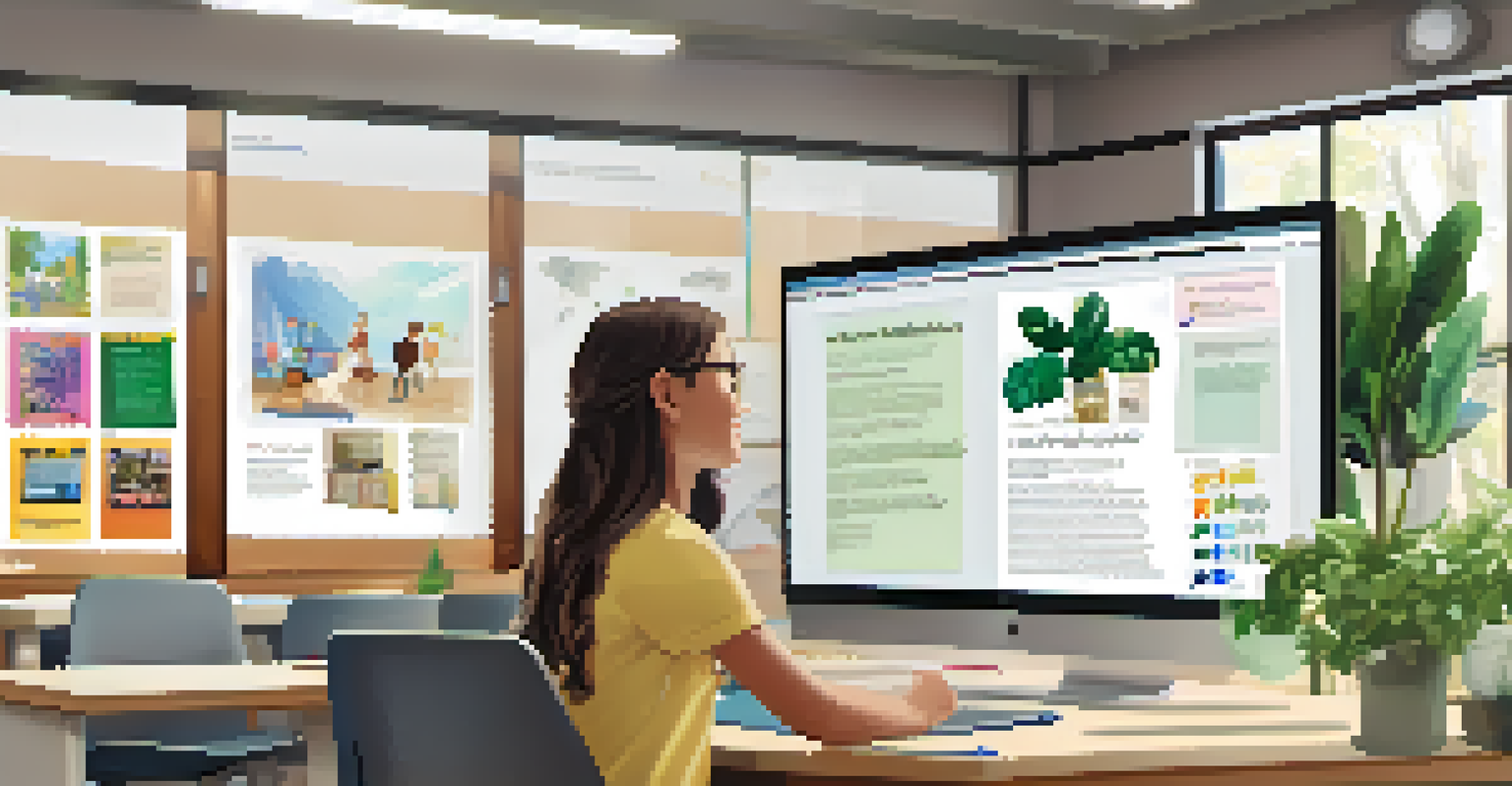Digital Portfolios: A Modern Approach to Student Assessment

Understanding Digital Portfolios and Their Purpose
Digital portfolios are online collections that showcase a student's work and achievements over time. They serve as a dynamic platform where students can document their learning journey, skills, and personal growth. Unlike traditional assessments, which often focus on a single snapshot in time, digital portfolios provide a more comprehensive view of a student's capabilities.
A digital portfolio is a way for students to showcase their ability to learn, create, and reflect on their experiences.
These portfolios can include various formats such as essays, projects, videos, and even reflections on learning experiences. This diversity allows students to present their strengths in a way that feels authentic to them. By encouraging creativity, digital portfolios foster a sense of ownership over one's learning.
Furthermore, they are easily accessible, making it convenient for educators, students, and parents to review progress. As technology continues to evolve, the role of digital portfolios in education is becoming increasingly significant, offering a modern approach to assessment.
Benefits of Digital Portfolios for Students
One of the most significant advantages of digital portfolios is that they empower students to take control of their learning. By curating their work, students can reflect on their progress and identify areas for improvement. This self-assessment encourages a growth mindset, helping students understand that learning is an ongoing journey.

Moreover, digital portfolios provide students with the opportunity to showcase their skills to future educators and employers. In today’s competitive world, having a well-organized digital portfolio can set a student apart during college admissions or job applications. It’s essentially a visual resume that highlights not just academic achievements but also personal interests and skills.
Digital Portfolios Showcase Growth
Digital portfolios provide a comprehensive view of a student's learning journey, highlighting their achievements and skills over time.
Additionally, students can receive constructive feedback from peers and teachers, which can be easily incorporated into their portfolios. This collaborative aspect enhances the learning experience and promotes a supportive classroom environment.
Digital Portfolios and Student Engagement
Engagement is key to effective learning, and digital portfolios play a vital role in this aspect. By allowing students to express their individuality through their work, they are more likely to be invested in the learning process. When students can choose what to include in their portfolios, they are more motivated to produce quality work.
The purpose of a portfolio is to provide a comprehensive view of a student's capabilities and growth over time.
This personalized approach also fosters creativity and critical thinking. Students are challenged to think about how to best represent their learning and experiences, which can lead to deeper understanding and retention of knowledge. For instance, a student might create a video project to illustrate a concept, further solidifying their grasp of the material.
Moreover, sharing portfolios with classmates can spark discussions and inspire collaboration. This peer interaction not only builds community but also enhances learning as students learn from one another's perspectives and skills.
The Role of Educators in Facilitating Digital Portfolios
While students take the lead in creating their digital portfolios, educators play a crucial role in guiding the process. Teachers can help set clear objectives, ensuring that students understand what to include and how to reflect on their work meaningfully. This guidance provides structure without stifling creativity.
Additionally, educators can model effective portfolio practices by sharing their own examples. By showcasing their work, teachers can demonstrate how to curate a portfolio and highlight the importance of ongoing reflection and assessment. This transparency builds trust and encourages students to invest in their portfolios.
Empowerment Through Self-Reflection
Students gain control of their learning by curating their work, fostering a growth mindset and enhancing their engagement.
Furthermore, educators can integrate digital portfolios into the curriculum, aligning them with learning outcomes and assessments. This harmony ensures that portfolios are not just an add-on but an integral part of the learning experience.
Challenges of Implementing Digital Portfolios
Despite their many benefits, implementing digital portfolios comes with challenges. One significant hurdle is the accessibility of technology. Not every student may have access to the necessary devices or internet connections, which can create disparities in the learning experience.
Another challenge is the time commitment required for both students and educators. Creating a meaningful digital portfolio takes time, and finding space within an already packed curriculum can be difficult. Educators need to balance the benefits with the practicalities of their teaching schedules.
Lastly, some students may feel overwhelmed by the idea of showcasing their work online. They might worry about privacy or fear judgment from peers. Addressing these concerns through discussions and providing a safe environment can help alleviate anxiety and encourage participation.
Tools and Platforms for Creating Digital Portfolios
Fortunately, there are numerous tools and platforms available to help students create digital portfolios easily. Websites like Google Sites, Seesaw, and Padlet offer user-friendly interfaces that allow students to compile their work with minimal technical skills. These platforms often come with templates, making it easier to get started.
Many of these tools also support multimedia content, enabling students to incorporate videos, images, and audio recordings into their portfolios. This flexibility allows for creativity and personalization, making each portfolio unique to the student.
Educators Guide Portfolio Development
Teachers play a crucial role in facilitating digital portfolios by providing structure, model practices, and integrating them into the curriculum.
Moreover, some platforms offer collaborative features, enabling peer feedback and group projects. This fosters a sense of community and encourages students to learn from each other, enhancing the overall educational experience.
Looking Ahead: The Future of Digital Portfolios
As we look to the future, digital portfolios are likely to become an even more integral part of education. With the ongoing advancements in technology and the growing emphasis on personalized learning, these portfolios can adapt to meet the needs of diverse learners. They offer a platform for students to not only display their work but also to reflect on their growth and set future goals.
Moreover, as educators become more familiar with digital portfolios, the quality and accessibility will improve. Schools may implement training programs for teachers to better understand how to support students in this process. This professional development will ensure that digital portfolios are used effectively as tools for assessment.

Ultimately, digital portfolios represent a shift towards a more holistic approach to student assessment, one that embraces individuality and creativity. By prioritizing student voice and choice, we pave the way for a more engaging and meaningful learning experience.